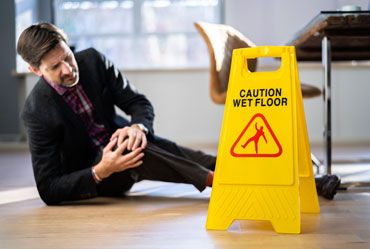Search

Slip and fall accidents are common occurrences that can lead to significant injuries and consequentially impact one’s life. While they may seem trivial at first glance, these mishaps can result in serious harm, ranging from minor bruises to severe fractures, head injuries, or even spinal damage. Understanding the causes, preventive measures, and legal aspects of slip and fall accidents is crucial for ensuring safety and knowing your rights.
Slip and fall accidents can occur almost anywhere, from a local grocery store to your own home. The most prevalent causes include wet or uneven surfaces, poor lighting, cluttered walkways, and weather conditions like ice or rain. In public places, such as malls, restaurants, or parks, management is often responsible for maintaining a safe environment. Poor maintenance, like neglecting to clean spills or repair broken handrails, can create hazardous conditions. At home, similar risks can stem from neglecting repairs or not adequately preparing for seasonal weather conditions.
Preventing slip and fall accidents requires a proactive approach in identifying potential hazards and addressing them promptly. Here are some key prevention tips:
1. Maintain Clear Walkways: Ensure all pathways, especially in high-traffic areas, are free from obstacles. Regularly declutter spaces to prevent accidental trips.
2. Install Adequate Lighting: Proper lighting can significantly reduce the risk of tripping over unseen objects. Make sure both indoor and outdoor areas are well-lit.
3. Use Non-Slip Mats: In areas prone to moisture, such as bathrooms and kitchens, use non-slip mats to provide additional grip and prevent slips.
4. Regularly Inspect and Repair: Routine checks for any potential hazards, like loose tiles or handrails, can prevent accidents. Timely repairs are critical.
5. Wear Appropriate Footwear: Shoes with good grip and support can help in maintaining balance, especially on slippery surfaces.
6. Prepare for Weather Conditions: During winter, use salt or sand to manage ice on walkways. Installing gutter guards can also prevent water pooling.
If you’re involved in a slip and fall accident, there are legal considerations you should be aware of, especially concerning liability. In essence, property owners have a duty of care to ensure their premises are safe. Should they fail to meet this obligation, they may be held liable for injuries sustained on their property due to negligence.
The legal process involves proving that the property owner was aware, or should have been aware, of the hazard and failed to rectify it. Documenting the incident, gathering evidence, such as photographs and witness statements, and seeking medical attention as soon as possible are critical steps in establishing a solid legal case.
Navigating the complexities of a slip and fall case can be daunting. Consulting with a personal injury attorney can provide valuable guidance. They can help assess the strength of your case, negotiate with insurance companies, and ensure you receive fair compensation for medical expenses, lost wages, and any suffering endured.
While slip and fall accidents can be unexpected, understanding their risks and taking preventive measures can significantly reduce the likelihood of an incident. Whether at home or in public, safety should always be a priority. Moreover, being informed about your legal rights can empower you to take the necessary actions if you ever find yourself in such a situation. Prioritizing safety and awareness can help you navigate life’s surfaces with confidence and security.